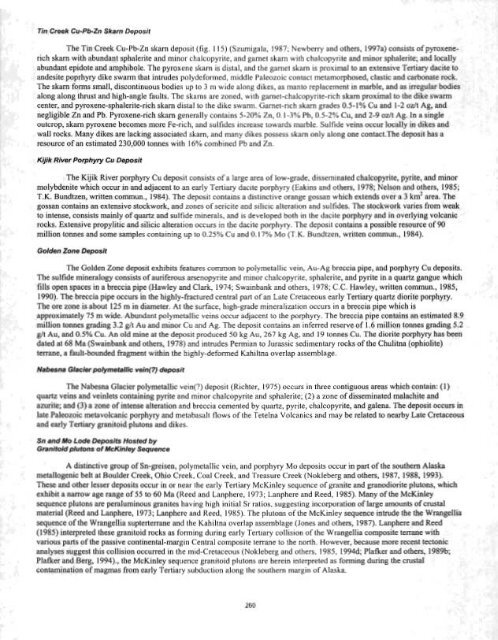Metallogenesis and Tectonics of the Russian Far East, Alaska, and ...
Metallogenesis and Tectonics of the Russian Far East, Alaska, and ...
Metallogenesis and Tectonics of the Russian Far East, Alaska, and ...
Create successful ePaper yourself
Turn your PDF publications into a flip-book with our unique Google optimized e-Paper software.
i<br />
Tln Creek Cu-Pb-Zn Sknn Deposit<br />
The Tin Creek Cu-Pb-Zn skarn deposit (fig. 1 15) (Szurnigala, 1987; Newberry <strong>and</strong> o<strong>the</strong>rs, 1997a) consi* <strong>of</strong> pyroxenerich<br />
skm with abundnpl sphalerite <strong>and</strong> minor chalcopyrite, <strong>and</strong> garnet skarn with chalcopyrite <strong>and</strong> minor qhaletile; <strong>and</strong> locally<br />
abundant cpibte <strong>and</strong> amphble. The pyroxene skarn is distal, <strong>and</strong> <strong>the</strong> garnet skarn is proximal to an extensive Tertiary &cite to<br />
<strong>and</strong>esite poprhyry dike swam thar intnrdes polydeformed, middle Paleozoic contact metamorphosed, claslic a d carbwak mck.<br />
The skam hms small. discontinuous bodies up to 3 m wide along dikes, as manto replacement in marble, <strong>and</strong> as irrephrbadies<br />
along along thrust <strong>and</strong> high-angle faults. The skams are zoned, w~th garnet-chalcopyrite-rich skarn proximal to <strong>the</strong> dike swam<br />
cenler, a& pyroxem-awerite-richskam distal to <strong>the</strong> dike swarm. Garnet-rich skam grades 0.5- 1% Cu <strong>and</strong> 1-2 ozti A& <strong>and</strong><br />
neghgible Zn <strong>and</strong> Pb. Pyroxene-rich sharn generally contains 5-20% Zn, 0.1-3% Pb, 0.5-2% Cu, <strong>and</strong> 2-9 oalt Ag. In a aingle<br />
oulcrop, skarn proxcne bccom mare Fe-rich, <strong>and</strong> sulfides increase towards marble. Sulfide veins occw locally in dikes md<br />
I w d rocks. Many dikes are lacking associated skarn, <strong>and</strong> many dikes possess skarn only along one contect.'lhe deposit has a<br />
resource <strong>of</strong> an estimated 230,000 tonnes with 16% combined Pb <strong>and</strong> Zn.<br />
I<br />
I<br />
The Kijik River porphyry Cuckposit consists <strong>of</strong> a large area <strong>of</strong> low-grade, disseminated chalcopyrite, pyrite, d minor<br />
molybdenite which o m in <strong>and</strong> @amnt to an early Tertiary dacite porphyry (Eakins <strong>and</strong> o<strong>the</strong>rs, 1978; Nelson <strong>and</strong> o<strong>the</strong>rs, 1985;<br />
T.K. &adken, writtea commun., 1984). The deposit contains a distinctive orange gossan which extends over a 3 k d area. The<br />
gossan contains an exiensive sbckwork, <strong>and</strong> zones <strong>of</strong> sericite <strong>and</strong> silicic alteration <strong>and</strong> sulfides. The stockwart varies from weak<br />
I to intense, cansuts mainly <strong>of</strong> quartz a d sulfide minerals, <strong>and</strong> is developed both in <strong>the</strong> dacite porphyry <strong>and</strong> in overlying vdcanic<br />
rocks. Evlensive propylitic <strong>and</strong> silicic alteration occurs in <strong>the</strong> dacite porphyry. The deposit conlains a possiMe r m e af 90<br />
d o n tomes <strong>and</strong> some samples containing up to 0.25% Cu <strong>and</strong> 0.17% Mo (T.K. Bundtzen, written wrnmun, 1984).<br />
Gdden Zone Deposit<br />
The Golden h e deposit exhibits features common to polymetallic vein, Au-Ag breccia pipe, <strong>and</strong> porphyry Cu deposits.<br />
The sulfide mineralogy consists ~f auriferous arsenopyrite <strong>and</strong> minor chalcopyrite, sphalerite, <strong>and</strong> pyritc in a quam gangue which<br />
fills open spaces in a breccia pipe (Hawley <strong>and</strong> Clark, 1974; Swainbank <strong>and</strong> o<strong>the</strong>rs, 1978; C.C. Hawley. wrilSeR commun., 1985,<br />
1990). The brecia pipe occurs in <strong>the</strong> highly-fractured central part <strong>of</strong> an Late Cretaceous early Tertiary quartz diorib porphyry.<br />
The are zone is about 125 m in diameter. At <strong>the</strong> surface, high-grade mineralization occurs in a breccia pipe whicb is<br />
approximately 75 m wide. Abundant polymetallic veins occur adjacent to <strong>the</strong> porphyry. The breccia pipe coatains an estimated 8.9<br />
million toones gradmg 3.2 g/t Au <strong>and</strong> minor Cu <strong>and</strong> Ag. The deposit contains an inferred reserve <strong>of</strong> 1.6 inision tomes grading 5.2<br />
glt Au, <strong>and</strong> 0.5% Cu. An dd mine at <strong>the</strong> deposit produced 50 kg Au, 267 kg Ag, <strong>and</strong> 19 tonnes Cu. The dioritc porphyry has been<br />
dated at 68 Ma (Swainbank ad o<strong>the</strong>rs, 1978) <strong>and</strong> intrudes Permian to Jurassic sedimentary rocks <strong>of</strong> <strong>the</strong> Chulitna (opbiolite)<br />
terranc, a faull-bounded Fragment within <strong>the</strong> highly-deformed Kahiltna overlap assemblage.<br />
Nabesna Glecisr polymeWHc veln(7) deposit<br />
The Nabesna Gkier polyrnetallic vein(?) deposit (Richter, 1975) occurs in three contiguous areas whicb contain: (1)<br />
quartz veins <strong>and</strong> veinlets containing pyrite <strong>and</strong> minor chalcopyrite <strong>and</strong> sphalerite; (2) a zone <strong>of</strong> disseminarad malachite <strong>and</strong><br />
azurite; <strong>and</strong> (3) a zone <strong>of</strong> iateme ahralion <strong>and</strong> breccia cemented by quartz, pyrite, chalcopyrite, <strong>and</strong> galena. The w i t occw in<br />
late Paleozoic melavolcanic porphyry <strong>and</strong> rnetabasalt flows <strong>of</strong> <strong>the</strong> Tetelna Volcanics <strong>and</strong> may be related to nearby Late Cretaceous<br />
<strong>and</strong> carly Tertiary granihid plutons <strong>and</strong> dikes.<br />
Sn <strong>and</strong> Mo Lode Deposits Hosted by<br />
Granitoid plutons o.f McKinley Sequence<br />
A distinctive group <strong>of</strong> Sn-greisen, polymetallic vein, <strong>and</strong> porphyry Mo deposits occur in part <strong>of</strong> <strong>the</strong> sou<strong>the</strong>m <strong>Alaska</strong><br />
metallogenic belt at Boulder Creek, Ohio Creek, Coal Creek, <strong>and</strong> Treasure Creek (Nokleberg <strong>and</strong> oihen, 1987, 1988,1993).<br />
These d o<strong>the</strong>r lesser deposits occur in ar near <strong>the</strong> early Tertiary McKinley sequence <strong>of</strong> grade <strong>and</strong> granodhite plulms, which<br />
exhibit a narrow age rage <strong>of</strong> 55 to 60 Ma (Reed <strong>and</strong> Lanphere, 1973; Lanphere <strong>and</strong> Reed, 1985). Many <strong>of</strong> <strong>the</strong> McKdey<br />
sequence plubons arc peraluminous granites having high initial Sr ratios, suggesting incorporation <strong>of</strong> Large amounts <strong>of</strong> cwtd<br />
material (Reed <strong>and</strong> Jspkere, 1973; Lanphere <strong>and</strong> Reed, 1985). The plutons <strong>of</strong> <strong>the</strong> McKinley sequence iatrude <strong>the</strong> <strong>the</strong> Wrangellh<br />
sequence <strong>of</strong> <strong>the</strong> Wrangcllia supterterrane <strong>and</strong> <strong>the</strong> Kahiltna overlap assemblage (Jones <strong>and</strong> o<strong>the</strong>rs, 1987). Lanphere <strong>and</strong> Reed<br />
(1985) interpreted <strong>the</strong>se graniloid rocks as forming during early Tertiary collision <strong>of</strong> <strong>the</strong> Wrangellia composite termne with<br />
various parts <strong>of</strong> <strong>the</strong> passive continental-mgin Central composite terrane to <strong>the</strong> north. However, because more recent leclonic<br />
analyses suggest this collision occurred in <strong>the</strong> mid-Cretaceous (Nokleberg <strong>and</strong> o<strong>the</strong>rs, 1985, 1994d; Plafker <strong>and</strong> o<strong>the</strong>rs, 198%;<br />
Phfker a d Bwg, 1994)., tbe McKinley sequence granitoid plutons are herein interpreted as forming dwing tbe crustal<br />
conlamhitian d magmas Born early Tertiary subduction along <strong>the</strong> sou<strong>the</strong>rn margin <strong>of</strong> <strong>Alaska</strong>.
















